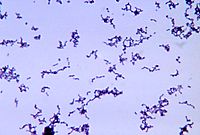
Photo from wikipedia
Background Coagulase-negative staphylococci (CNS) survive as commensals of skin, anterior nares and external canals of human and were regarded as non-infectious pathogens. However, they are emerging as a major cause… Click to show full abstract
Background Coagulase-negative staphylococci (CNS) survive as commensals of skin, anterior nares and external canals of human and were regarded as non-infectious pathogens. However, they are emerging as a major cause of nosocomial infectious due to their ability to form biofilms and high resistance to several classes of antibiotics. This study examines the biofilm forming abilities of 214 clinical CNS isolates using phenotypic and genotypic methods, and determines their antibiotic susceptibility patterns. Methods A total of 214 clinical isolates collected from different clinical samples were identified as CNS and their antibiotic susceptibility determined by CLSI guidelines. The biofilm forming ability of all isolates was determined by three phenotypic methods; Congo red agar (CRA) method, tube adherence method (TM) and tissue culture plate (TCP) method and by genotypic method for the detection of icaAD genes. Results Among all the isolates, S. epidermidis (57.5%) was found the most frequently, followed by S. saprophyticus (18.7%) , S. haemolyticus (11.2%) , S. hominis (7%), and S. capitis (5.6%). Antibiotic susceptibility pattern demonstrated 91.6% isolates were resistant to penicillin and 66.8% to cefoxitin while 91.1% isolates were susceptible to chloramphenicol. Constitutive and inducible clindamycin resistant phenotype as measured by D-test was seen among 28% and 14.5% of isolates respectively. Tissue culture plate method detected biofilm production in 42.1% isolate followed by 31.8% through tube method while 20.1% isolates were found to produce slime in Congo red agar method. The genotypic assay revealed presence of icaA and icaD genes in 19.2% isolates. Conclusion The study shows a high prevalence of biofilm formation and inducible clindamycin resistance in CNS isolates, indicating the importance of in-vitro biofilm production test and D-test in routine laboratory diagnostics. Implementation of efficient diagnostic techniques for detection of biofilm production in clinical samples can help manage staphylococcal infections and minimize risks of treatment failures in hospitals.
Journal Title: Annals of Clinical Microbiology and Antimicrobials
Year Published: 2021
Link to full text (if available)
Share on Social Media: Sign Up to like & get
recommendations!